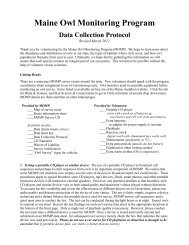Focus Species Forestry - Maine Audubon
Focus Species Forestry - Maine Audubon
Focus Species Forestry - Maine Audubon
You also want an ePaper? Increase the reach of your titles
YUMPU automatically turns print PDFs into web optimized ePapers that Google loves.
8. Property-Wide and Landscape-Scale <strong>Forestry</strong><br />
<strong>Focus</strong> species management integrates management at both the stand and landscape scales by<br />
identifying a suite of species with different habitat requirements and territory sizes. Since some<br />
focus species like the marten and goshawk require suitable habitat conditions at the landscape<br />
scale, forest managers must consider how management of individual stands will affect the overall<br />
mix of forest age classes and types at the landscape scale. Small woodland owners cannot<br />
manage at the landscape scale, but they can manage at the overall property level, not just stand<br />
by stand, and adjust management based on surrounding<br />
landscape conditions.<br />
Stands and Landscapes<br />
Following are some basic principles of landscape-scale<br />
ecology.<br />
Habitat Loss and Fragmentation<br />
Habitat loss is the conversion of one habitat type to another,<br />
for example the conversion of mature forest to young forest,<br />
or the loss of the forest itself when it is converted to<br />
development or agriculture. Forest harvesting may result in<br />
temporary loss of mature forest, but conversion to nonforest<br />
is permanent.<br />
Habitat fragmentation occurs when a relatively large patch<br />
of habitat is cut into smaller patches. This may occur by<br />
perforation, which occurs when many smaller cuts are<br />
scattered throughout a large forest block, or when scattered<br />
A stand is a unit of forestland typically<br />
delineated on the basis of species, size,<br />
and density of trees. Most forest<br />
management maps delineate forest<br />
stands. Stands typically range in size<br />
from a few acres to several hundred<br />
acres. Stand-level management is the<br />
fundamental building block of forestry<br />
and focus species management.<br />
A landscape is a large-scale mosaic of<br />
forest stands and other non-forested<br />
community types and ecosystems such as<br />
bogs and streams. Landscapes may range<br />
in size from thousands of acres to tens of<br />
thousands of acres.<br />
homes are built in a forested area. The other end of the fragmentation spectrum is isolation,<br />
which occurs when harvesting or development results in habitat patches that are surrounded by<br />
large areas of dissimilar habitat. Studies have shown that habitat isolation is generally a greater<br />
threat than perforation, especially when the size of the remaining patch is small relative to the<br />
habitat needs of an animal.<br />
Habitat connectivity is the inverse of habitat isolation, and occurs when patches of suitable<br />
habitat are located adjacent to one another or are connected by travel corridors.<br />
Habitat loss and fragmentation typically occur together and may have a compounding effect, and<br />
scientists sometimes have a difficult time identifying which effect is the strongest.<br />
Habitat Interspersion and Large Forest Patches<br />
Habitat interspersion occurs when different habitat types occur adjacent to one another. Some<br />
animals prefer a high level of interspersion in relatively small patches. For example, the ruffed<br />
grouse does best when three age classes in 1-10-acre patches ranging from regeneration to<br />
intermediate or mature stands are interspersed in a 10-50-acre area. In contrast, American marten<br />
<strong>Focus</strong> <strong>Species</strong> <strong>Forestry</strong> 65



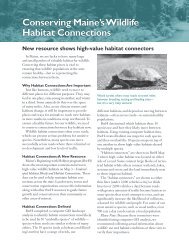
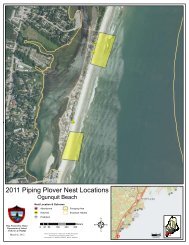
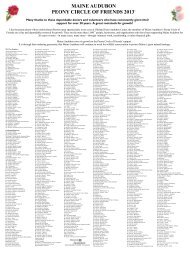
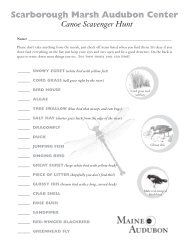

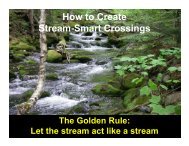
![2012 Loon Count Results [pdf] - Maine Audubon](https://img.yumpu.com/26228732/1/190x245/2012-loon-count-results-pdf-maine-audubon.jpg?quality=85)
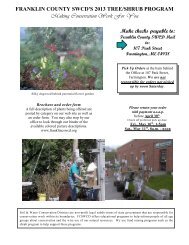
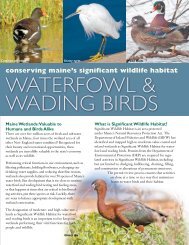
![Lake Fish of Maine (DIFW list) [pdf] - Maine Audubon](https://img.yumpu.com/23282964/1/190x245/lake-fish-of-maine-difw-list-pdf-maine-audubon.jpg?quality=85)
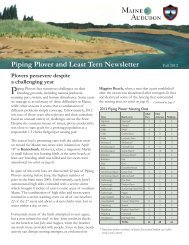

![The Maine Audubon Peony Circle of Friends 2012 [pdf]](https://img.yumpu.com/22707677/1/190x253/the-maine-audubon-peony-circle-of-friends-2012-pdf.jpg?quality=85)
